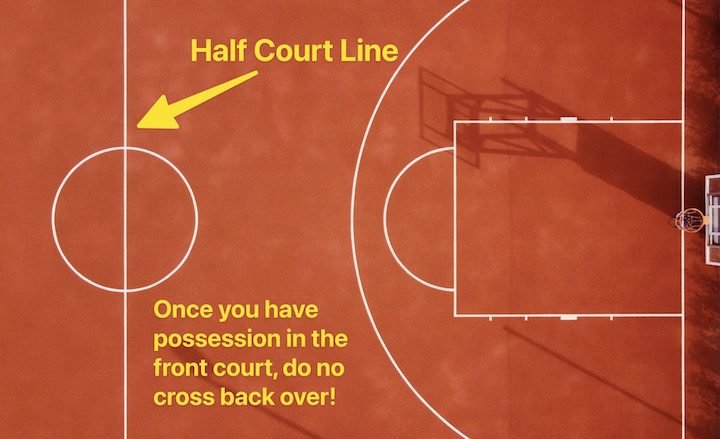Backcourt violation in basketball occurs when a player with possession of the ball steps or dribbles into the backcourt after crossing the half-court line. This results in a turnover, giving the opposing team possession of the ball. Understanding the backcourt violation rule is crucial for players and fans alike, as it can greatly impact the flow and outcome of the game. Let’s delve deeper into what constitutes a backcourt violation and how it influences the course of play.
What is Backcourt Violation in Basketball?
Welcome to our blog where we are going to dive into the exciting world of basketball and discuss one of the fundamental rules of the game – backcourt violation. Whether you are new to basketball or a seasoned player, understanding the concept of backcourt violation is crucial for enjoying and playing the game effectively. So, let’s explore what backcourt violation in basketball is all about!
The Basics of Backcourt Violation
Backcourt violation is a rule in basketball that prohibits the offensive team from returning the ball to the backcourt once it has been advanced to the frontcourt. In simpler terms, once the ball crosses the half-court line into the frontcourt, the offensive team must ensure that the ball does not go back into the backcourt unless there is a legitimate reason, such as a defensive deflection.
Understanding the Half-Court Line
The half-court line is a crucial boundary that divides the basketball court into two halves – the frontcourt and the backcourt. It is located at the center of the court and serves as a reference point for determining the offensive and defensive areas for each team.
When the offensive team gains possession of the ball, they must bring it from the backcourt to the frontcourt by crossing the half-court line within a specified time limit, known as the shot clock. Once the ball crosses into the frontcourt, the offensive team is not allowed to bring it back into the backcourt unless certain conditions are met.
Exceptions to Backcourt Violation
While backcourt violation is a strict rule in basketball, there are certain exceptions and scenarios where the offensive team is permitted to return the ball to the backcourt without facing a violation. It is important to understand these exceptions to avoid turnovers and maintain possession of the ball.
Defensive Deflection
One common exception to backcourt violation is when the ball is deflected or tipped by a defensive player, causing it to return to the backcourt. In such cases, the offensive team is allowed to recover the ball in the backcourt without being penalized for a violation.
Shot Clock Reset
Another exception to backcourt violation occurs when the shot clock is reset during gameplay. If the shot clock is reset due to a foul, timeout, or other stoppage in play, the offensive team is given a new possession and can bring the ball back into the backcourt without facing a violation.
Consequences of Backcourt Violation
Violation of the backcourt rule results in a turnover, where possession of the ball is awarded to the opposing team. This can be detrimental to the offensive team as it not only leads to a lost scoring opportunity but also gives the opponent a chance to capitalize on the turnover and score points.
Backcourt violations are called by referees during gameplay, and it is essential for players to be aware of their positioning on the court to avoid committing this infraction. By understanding the rules and nuances of backcourt violation, teams can execute plays effectively and maintain possession of the ball.
Practicing Backcourt Awareness
To prevent backcourt violations and enhance overall gameplay, players can work on developing their backcourt awareness through practice and drills. By improving their ball-handling skills, court vision, and understanding of the game’s dynamics, players can minimize errors and make informed decisions on the court.
Coaches play a crucial role in guiding players on backcourt rules and strategies to ensure smooth gameplay and effective ball movement. By emphasizing the importance of backcourt violation and its implications, coaches can help players elevate their performance and teamwork on the court.
In conclusion, backcourt violation is a fundamental rule in basketball that regulates the movement of the ball between the frontcourt and backcourt areas of the court. By understanding the basics of backcourt violation, exceptions to the rule, and consequences of violations, players and teams can enhance their gameplay and avoid turnovers.
Next time you watch a basketball game or hit the court to play, remember the importance of backcourt violation and strive to execute plays with precision and awareness. Stay tuned for more exciting basketball insights and tips on our blog!
How do you know when it's a backcourt violation or not? Let's talk it through on, Rule Review.
Frequently Asked Questions
What constitutes a backcourt violation in basketball?
A backcourt violation in basketball occurs when the offensive team fails to bring the ball from the backcourt into the frontcourt before the shot clock expires. This violation results in a turnover, giving possession of the ball to the opposing team.
When does a backcourt violation occur?
A backcourt violation occurs when a player with the ball steps or dribbles into the backcourt while the team is in possession of the ball. This violation can happen during an inbound pass, after crossing into the frontcourt, or when the shot clock is running.
Is it considered a backcourt violation if the defensive team deflects the ball into the backcourt?
No, if the defensive team deflects the ball into the backcourt, the offensive team can legally retrieve the ball without it being considered a backcourt violation. The violation only occurs if a player from the offensive team is the one who causes the ball to go into the backcourt.
Final Thoughts
In basketball, a backcourt violation occurs when the offensive team fails to bring the ball across the half-court line within the allotted time. This infraction results in a turnover, giving possession to the opposing team. Understanding what a backcourt violation is crucial for both players and fans to grasp the rules of the game. It is a fundamental concept that impacts the flow and momentum of a basketball match. Remember, avoiding backcourt violations is essential for maintaining possession and scoring opportunities in basketball.




